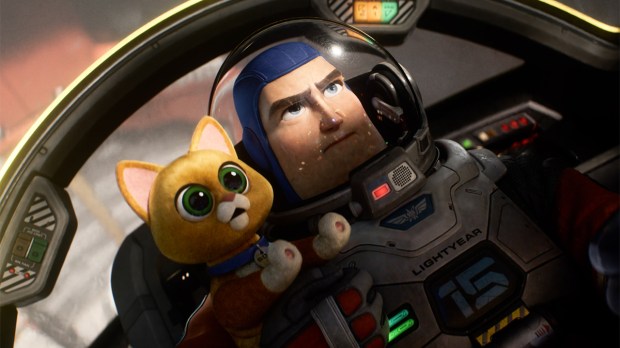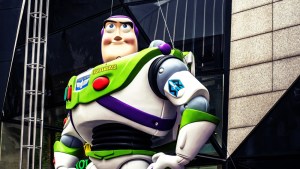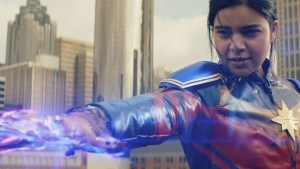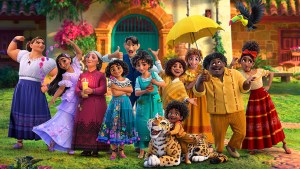“A kiss, but all in all, what is it?” asks Cyrano de Bergerac with grace and levity under the balcony of the beautiful Roxane. But when a kiss is instrumentalized and used to advocate for LGBT rights in a children’s movie, it becomes a very different issue.
Fans of Buzz Lightyear, the toy character in the Toy Story films, know the arrogant astronaut’s motto: “To infinity and beyond!” Disney and Pixar studios seem to have appropriated the motto in their race to promote LGBTQIA+ rights. It’s as if they wanted to apologize, or even repent, for the decades of Disney princesses kissing and marrying Prince Charmings in front of the eyes of millions of young viewers.
While Disney cleverly maintains the mystery and the rumors around the sexual orientation of Frozen‘s Elsa or the young Mirabel of the movie Encanto (2021), thus sparing innocent pairs of eyes to whom it does not matter, the American studios go a step further this year by revealing in the movie Lightyear, now showing, a kiss between two lesbian women. If the scene is described as fleeting, it is probably enough to disturb more than one young soul.
The scene has been prohibited in a dozen countries of the Middle East and Asia with Muslim majority: Bahrain, Egypt, Indonesia, Iraq, Jordan, Kuwait, Lebanon, Malaysia, Oman, Qatar, Saudi Arabia, Syria and the United Arab Emirates.
“We were warned that this would be a likely outcome,” said American producer Galyn Susman. “But we weren’t going to change the film we wanted to make just because of some countries with — for lack of a better term — backward beliefs,” she added.
In Peru, a chain of cinemas, Cine Planet, had attached the warning “gender theory” to the programming on June 16. But facing so much controversy, the distribution company finally announced on June 18 that the warning was not appropriate.
50% of Disney characters should be gay?
The kissing scene was initially cut by Disney’s subsidiary Pixar Studios. But some employees of these companies protested, accusing the world’s number one entertainment company of not being committed to advancing the rights of LGBT people. The scene was therefore reinstated.
Willingness on the part of Disney to show a strong commitment to the LGBT community is not new. But it has grown considerably in recent years, particularly with the launch of their Reimagine Tomorrow platform. The platform’s aim is to “amplify underrepresented voices and unknown stories,” and to reaffirm “Disney’s long-standing commitment to diversity, equity and inclusion.”
It was via this platform, launched on the occasion of Black History Month in 2021, that Karen Burke, head of the TV arm of 20th Century Fox, a Disney subsidiary, said last April that half of the characters in future Disney films should be “gay or from LGBTQIA+ communities.” This video caused an outcry, and the hashtag #BoycottDisney trended on Twitter.
A better ally for the LGBT community
Bringing gay, lesbian, trans or bisexual characters to the screen is a way for Disney to take a stand since a Florida law, nicknamed “Don’t say gay” by its opponents, was adopted in early March by the Florida Senate. Deemed homophobic by Democrats and LGBT advocates, the law prevents teachers from discussing gender identity and sexual orientation in kindergarten and elementary school.
Bob Chapek, the head of Disney — who initially took no position — was forced by some of his employees and by media pressure to publicly take a stand against the law. Pixar employees went so far as to release a letter on March 9 in which they accused Disney, their parent company, of censoring their attempts to include LGBT characters in feature films.
Two days later, Bob Chapek addressed them, apologizing for not supporting them. “Clearly, this is not just an issue that affects a Florida law, but rather a new challenge to basic human rights,” he wrote in an internal email published by entertainment media outlet Variety. “You needed me to be a stronger ally in this fight for equal rights and I failed you. I’m sorry,” Chapek continued.
As a result, the Disney boss said that his group would step up its efforts to prevent similar legislation from taking hold in other states. “And today, we are suspending all our political donations in the state of Florida” until further notice, he stressed. “I truly believe that we are an infinitely better and stronger company because of our LGBTQ+ community.”
Actor Chris Evans, who voices the animated Buzz in Lightyear, also took a stand in an interview with Variety: “I’m a little frustrated that this is even a topic of discussion. The goal is to get to a point where it’s the norm,” the Captain America star said. A point of view that does not seem to be that of the public. Released in theaters June 17 in the United States, Lightyear has not made the expected buzz. This spin-off of Toy Story was predicted to bring in 70 to 85 million dollars for its launch. It ended up bringing in $51 million. By comparison, Toy Story 4 brought in $118 million in 2019.
The kisses given to Snow White or Sleeping Beauty, far from any political or ideological instrumentalization, still have more charm. But above all, they have nothing figurative like this militant kiss, they are necessary to the story, they even have a vital function in the tale, that of bringing Snow White and Sleeping Beauty back to life, to transform the Beast into a young man and the Little Mermaid into a young woman. Alisha’s kiss in Lightyear is only there to satisfy a lobby.




